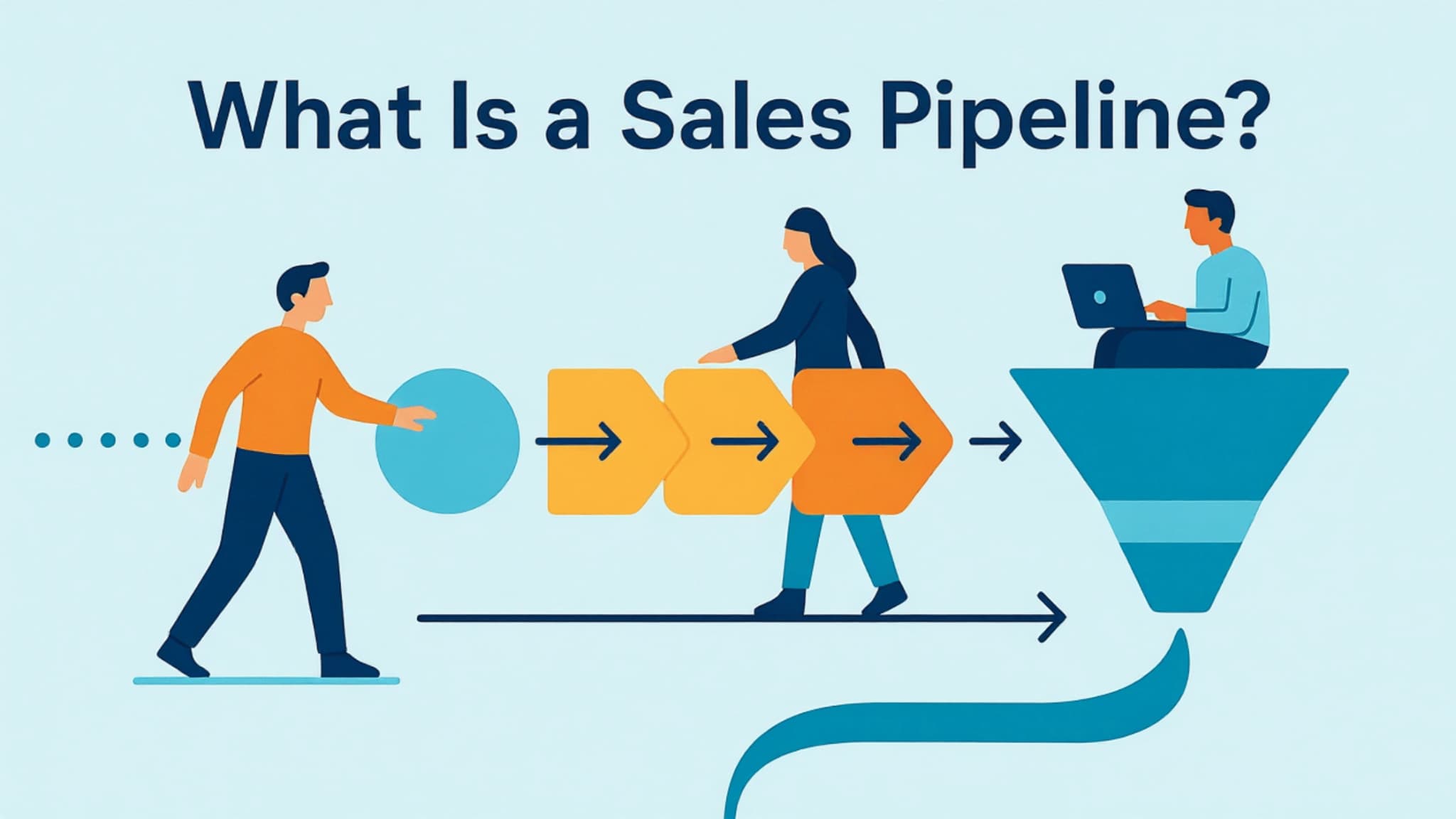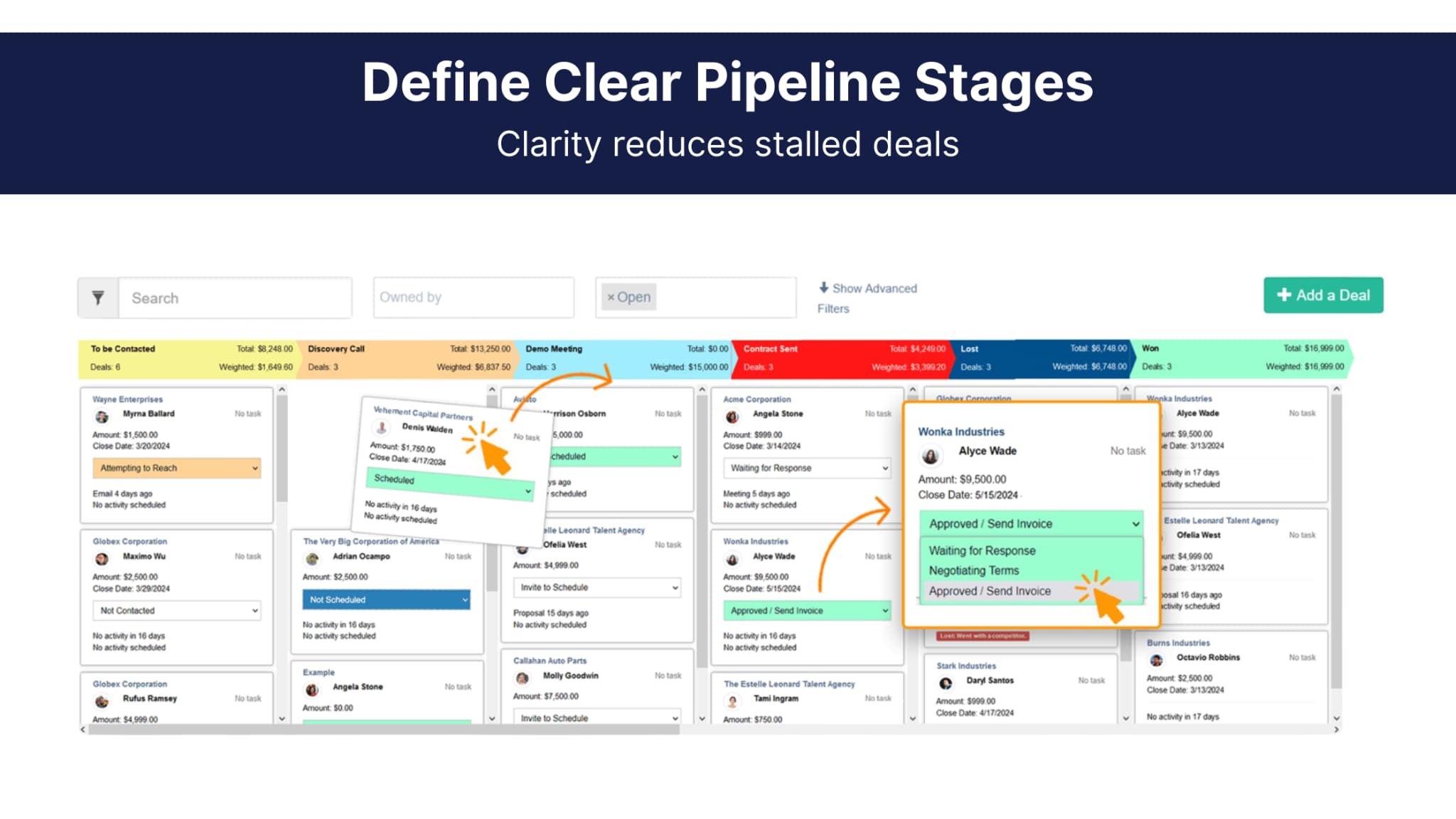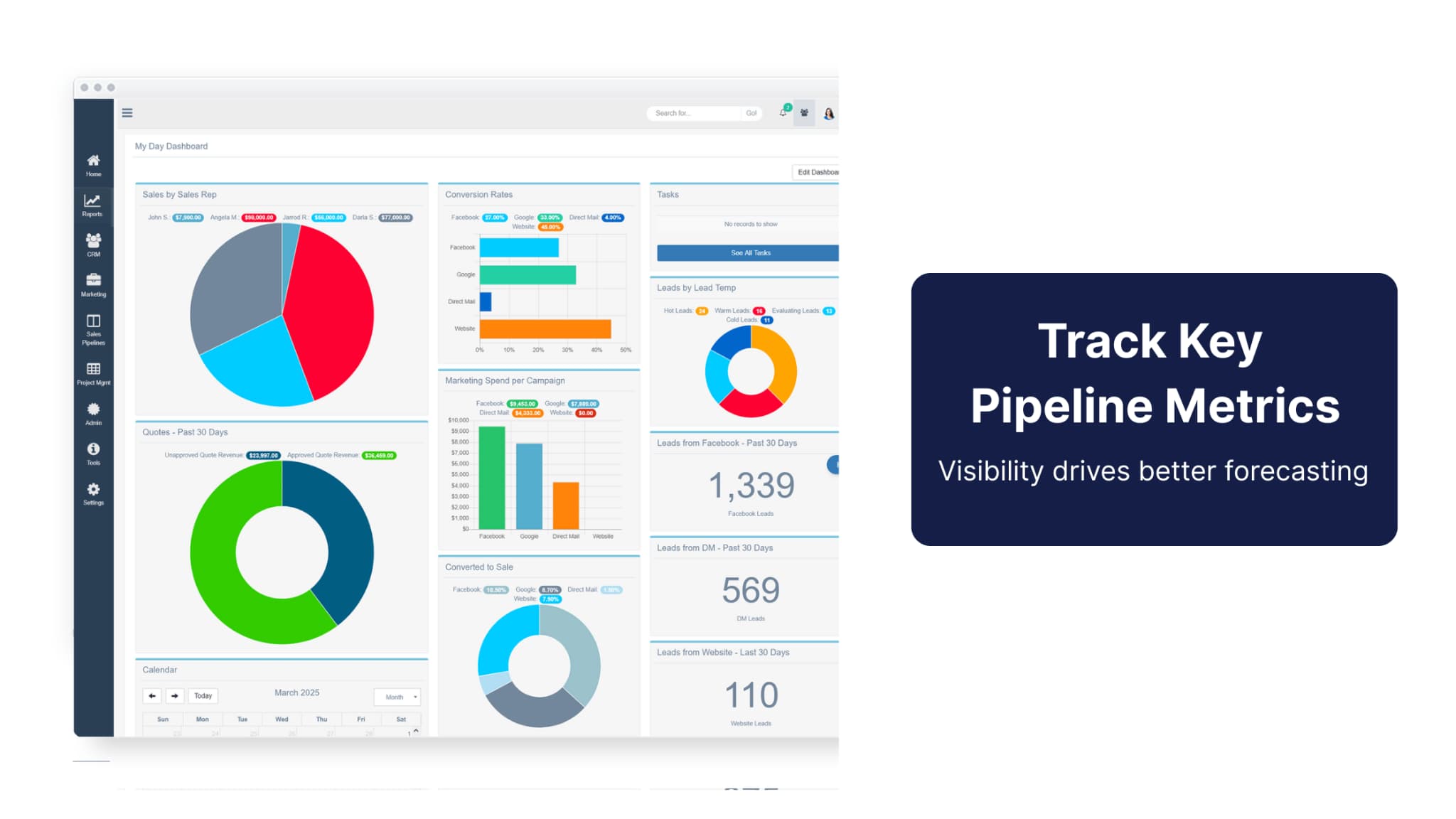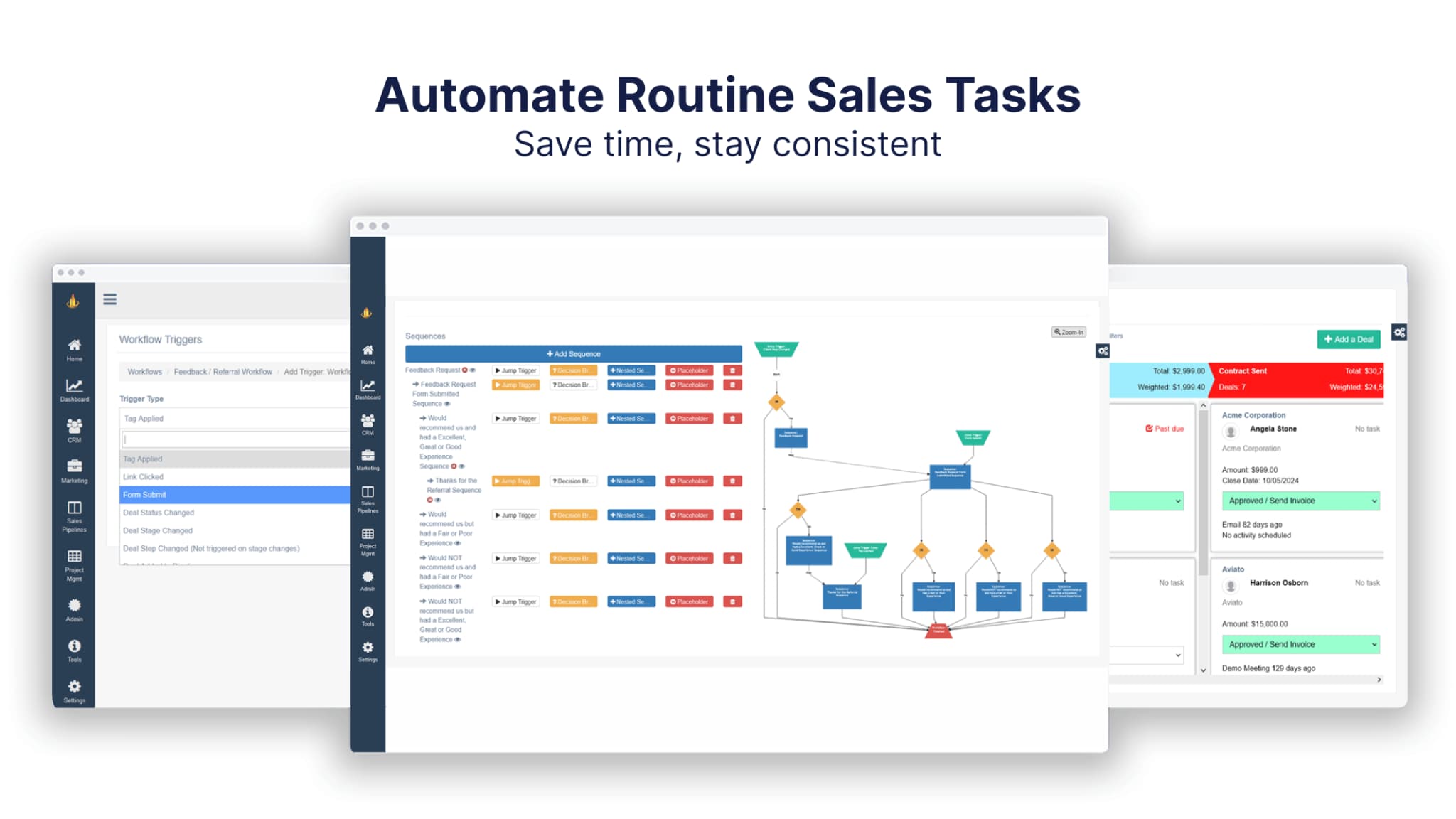15 Essential Strategies for Effective Sales Pipeline Management
by

- What Is a Sales Pipeline? (And Why It Matters)
- Sales Pipeline vs. Sales Funnel: What’s the Difference?
- A High‑Performing Sales Pipeline: Stages Explained
- 15 Essential Sales Pipeline Management Strategies
- 1. Define Clear Sales Pipeline Stages (Don’t Guess)
- 2. Standardize Lead Qualification Criteria
- 3. Use the Right CRM Tools (Not Spreadsheets)
- 4. Track Key Pipeline Metrics Consistently
- 5. Conduct Regular Pipeline Reviews
- 6. Maintain Accurate, Up‑to‑Date Customer Data
- 7. Shorten the Sales Cycle Where Possible
- 8. Focus on High-Value Opportunities
- 9. Improve Collaboration Between Sales & Marketing
- 10. Continuously Improve Your Sales Strategy
- 11. Automate Routine Sales Tasks
- 12. Segment Your Pipeline by Product or Market
- 13. Use Pipeline Forecasting Scenarios
- 14. Train Sales Teams on Pipeline Management
- 15. Align Your Pipeline with Your Overall Sales Strategy
- Conclusion
- FAQs
A healthy sales pipeline is more than a list of opportunities. It’s the engine that keeps your team organized, helps you make smarter decisions, and supports consistent revenue growth. Many sales teams don’t actually struggle to get leads; they struggle to guide those leads through the process in a clear and predictable way. When the path feels scattered or unstructured, deals slow down, follow‑ups get missed, and the pipeline becomes harder to trust.
This guide breaks down the fundamentals of pipeline management. You’ll get a clear picture of what a sales pipeline is, how it differs from a funnel, the stages that make up an effective pipeline, and the strategies to keep everything running smoothly. You’ll also learn how to keep your data clean, strengthen alignment across your team, and build habits that make forecasting more predictable.
Let’s start with the basics.
What Is a Sales Pipeline? (And Why It Matters)
Think of your sales pipeline as the roadmap for your entire sales process. It shows where every opportunity stands, what has already happened, and what still needs to happen. When it’s set up well, it creates structure and removes guesswork. According to a recent McKinsey report, companies with clearly defined sales processes outperform those without them by achieving up to 28 percent higher revenue consistency.
A promising pipeline also gives you an early signal when something isn’t moving the way it should. If follow‑ups slow down or deals start piling up in a single stage, you can spot the issue quickly instead of being surprised at the end of the month.
Most teams make the mistake of treating the pipeline like a to‑do list. But it’s much more valuable than that. It’s a framework that helps everyone understand what qualifies as real progress, preventing confusion and keeping deals moving forward.
Here’s a quick way to see why a pipeline makes such a difference:
| Benefit | What It Helps With | Why It Matters |
|---|---|---|
|
Visibility |
Knowing where every deal stands |
Reduces stalled deals |
|
Predictability |
More confident forecasting |
Better planning |
|
Accountability |
Shared expectations |
Easier coaching |
A well‑defined pipeline also keeps different departments aligned. Marketing can measure lead quality more accurately, operations can plan ahead, and leadership can make decisions based on clean, consistent data.

Sales Pipeline vs. Sales Funnel: What’s the Difference?
These two concepts are related, but they serve different roles.
A sales funnel focuses on volume. It shows how many people move from awareness to interest to consideration, and eventually to becoming customers.
A sales pipeline focuses on progress. It shows how close each deal is to closing and what actions are needed to keep things moving.
This simple comparison helps clarify their roles:
| Category | Sales Funnel | Sales Pipeline |
|---|---|---|
|
Focus |
Lead quantity |
Deal quality |
|
Best For |
Marketing insights |
Sales insights |
|
Shows |
Where leads drop off |
How deals move forward |
|
Answers |
“How many leads enter each funnel?” |
“How close are we to our sales goal?” |
Understanding both helps prevent confusion. For example, a struggling pipeline doesn’t always mean marketing is underperforming. The issue could be the timing of follow-up, qualification, or messaging.
A High‑Performing Sales Pipeline: Stages Explained
Most effective pipelines follow a similar structure. These stages act like checkpoints that help you understand how far along a deal is and what needs to happen next.
- Lead Generation – Where interest begins. Quality matters more than volume.
- Lead Qualification – Confirms whether the lead is worth pursuing.
- Needs Analysis – Helps identify the real goal or challenge the buyer wants to fix.
- Proposal / Presentation – You present a tailored solution.
- Negotiation – You work through questions, concerns, or adjustments.
- Closed Won / Lost – You record the outcome and lessons learned.
If your team struggles to decide which stage a deal belongs in, your pipeline might be too complicated. A clear, simple structure keeps everyone aligned.
Let Us Help You Get Started!
Pulse CRM delivers more than software. We’re your partner in success.
We fully set up your CRM, including importing your data, configuring sales and marketing automations, designing branded email templates, writing engaging email copy, setting up sales pipelines, and much more.
15 Essential Sales Pipeline Management Strategies
These strategies help you strengthen your pipeline step by step. They’re practical, easy to understand, and designed to work together.
1. Define Clear Sales Pipeline Stages (Don’t Guess)
The more clearly your stages are defined, the easier it becomes for your entire team to stay aligned. When stage criteria are vague, reps end up making their own interpretations, which leads to inconsistent forecasting and deals stalling without clear direction. This matters because a stage should feel almost self‑evident. Anyone on your team should be able to look at an agreement and instantly understand where it belongs.
It helps to picture your stages as meaningful moments in the buyer’s decision process rather than simple internal checkpoints. Each stage should reflect something the buyer has actually done that signals a more profound commitment. If a deal sits in a stage too long or doesn’t meet the criteria you’ve outlined, it’s often a sign the definition needs tightening. In fact, teams that regularly revisit their stage definitions tend to see fewer stalled deals because reps always know the next step to move a deal forward.
According to Pulse data, the most effective teams keep their pipelines simple enough for quick decisions but structured sufficiently to prevent ambiguity. One of the reasons Pulse sales pipelines work so well is the ability to add sub‑statuses within each stage, which keeps the process streamlined without creating an overly long pipeline that becomes hard to manage.
For example, within a Discovery Call stage, you can create sub‑statuses such as Not Scheduled, Invite to Schedule Call, Scheduled, Canceled, and No Show. Each of these can also serve as automation triggers, so a canceled status can automatically launch a reschedule email and text sequence. These sub‑statuses also enhance reporting, giving leaders a clearer picture of movement within a stage without cluttering your pipeline.
Reviewing your stages regularly, especially when using flexible tools like Pulse, ensures they continue to align with how buyers behave today, not how they did last year.
Why It Matters
- Reduces stalled deals because reps always know the next step
- Improves forecasting accuracy since stages reflect real buyer movement
- Helps reps understand when a stage is truly complete, not just “in progress.”
How to Implement
- Tie each stage to a specific sales milestone, so progress is easy to spot
- Keep the number of stages manageable to avoid overwhelming your sales team
- Review and update your stage definitions regularly as your sales process evolves
- Create well-documented SOPs and training videos so new reps ramp up faster

2. Standardize Lead Qualification Criteria
Not every lead deserves a spot in your pipeline, and treating them all the same can slow your team down. Standardizing your qualification criteria helps reps quickly determine who is genuinely ready to explore a solution and who still needs nurturing. This creates a healthier, more predictable pipeline because reps spend more time with buyers who have clear intent and the ability to move forward.
A consistent approach also strengthens your data. When every rep qualifies leads using the same criteria, patterns become easier to recognize. You start seeing which lead sources bring in the most promising prospects, which behaviors signal genuine interest, and where opportunities tend to fall off. Over time, this improves the quality of your forecasting and gives you better insight into how buyers make decisions.
Bringing clarity to qualification also reduces friction for reps. Instead of guessing whether a lead is ready, they have a simple checklist to guide the conversation. This helps them ask more focused questions, identify gaps early, and avoid moving deals forward that are likely to stall later.
Useful Frameworks
- BANT – Budget, Authority, Need, Timeline
- CHAMP – Challenges, Authority, Money, Prioritization
How to Apply
- Train everyone on the same qualification criteria, so conversations stay consistent
- Automate lead scoring when possible to reduce subjective decisions
- Review qualification patterns as buyer behavior changes, so your process stays relevant
- Provide examples of strong buying signals inside the CRM to help reps make quick, confident decisions
3. Use the Right CRM Tools (Not Spreadsheets)
Using the right CRM is one of the most significant upgrades you can make to your sales process. While spreadsheets can feel familiar and straightforward, they quickly become overwhelming as conversations multiply and deals move across different stages. They also make it challenging to keep everyone aligned because they don’t update in real time and often require manual cleanup.
A good CRM brings everything together in one place. It stores communication history, organizes your priorities, and makes it easier to see which deals need attention. It also helps leaders understand trends that might otherwise go unnoticed, such as where deals tend to stall or which marketing channels attract the most engaged leads.
CRMs also reduce repetitive work by automating simple tasks, helping reps stay focused on hot leads rather than on admin chores. As your pipeline grows, this becomes essential for maintaining consistency and improving efficiency.
What to Look For
- A clean visual pipeline that shows deal movement at a glance
- Automated reminders and tasks so follow‑ups never slip through the cracks
- Reporting dashboards that highlight trends and gaps
- Built-in marketing automation for email and text message marketing
A centralized system keeps the team aligned, reduces duplicate work, and gives everyone access to accurate data for planning.
4. Track Key Pipeline Metrics Consistently
Metrics give you clarity about what’s happening inside your pipeline. Without them, you end up relying on gut instinct instead of patterns.
When numbers become part of your regular rhythm, you start to see connections between rep activity, buyer behavior, and stage progression that would otherwise go unnoticed. This helps you catch slowdowns earlier and make more thoughtful decisions about where to focus your time.
In fact, research from Harvard Business Review found that companies that track pipeline metrics regularly are up to 15 percent more likely to hit their quarterly forecasts.
Strong metric tracking also supports coaching. When you can see trends in conversion rates or deal velocity, you can guide reps toward specific improvements instead of giving general feedback. For example, if a rep consistently loses deals after the proposal stage, it might signal a need for a more straightforward presentation or a deeper discovery.
Key Metrics
- Average deal size
- Conversion rates per stage
- Sales velocity
- Cycle length
- Pipeline coverage ratio
Tips for Better Tracking
- Review metrics weekly so changes are spotted early
- Compare performance trends consistently to understand what has improved or declined
- Use dashboards so everyone sees real-time data

5. Conduct Regular Pipeline Reviews
Reviews keep your pipeline healthy by making sure every deal has a clear next step. They give reps a chance to bring up questions, clarify details, and get support before problems escalate. These check-ins also help uncover minor issues that would otherwise go unnoticed, such as unclear next actions or outdated information that slows progress.
Regular reviews encourage reps to maintain cleaner notes, stay proactive with follow‑ups, and be more thoughtful about deal movement. They also give leaders a chance to spot patterns, such as slow-moving stages or repetitive objections, so they can offer timely coaching.
What to Look For
- Accurate stage placement
- Timely follow-ups
- Missing information
- Potential risks
- Deals that need requalification
- Patterns in stalled stages that may signal deeper process issues
Shorter, more frequent reviews usually work best because they help you catch problems early and keep the entire pipeline moving with steady momentum.
As you conduct regular reviews, it becomes clear that none of it works without trustworthy data.
6. Maintain Accurate, Up‑to‑Date Customer Data
Clean data keeps your pipeline reliable. Even small mistakes, like an outdated email address or an outdated deal amount, can disrupt forecasting and create confusion. When teams rely on inaccurate details, follow-ups occur at the wrong times, proposals miss the mark, and deals may appear more promising than they actually are. This slows down momentum and makes it harder for leaders to predict revenue with confidence.
Keeping your data current also helps you identify patterns more accurately. For example, spotting which lead sources produce the highest-quality prospects becomes much easier when records are clean. And when information is updated consistently, it reduces friction between sales, marketing, and operations because everyone can trust they’re looking at the same truth.
Simple Ways to Keep Data Clean
- Verify contact details often
- Remove duplicates regularly
- Log conversations right away
- Standardize how data is entered
- Review deal amounts before forecasting
Good data also improves communication across teams, since everyone is working with the same information.
Once your data is clean and consistent, you’ll usually notice how timing affects momentum. Minor delays can cause big slowdowns, which is why tightening your sales cycle becomes the next logical focus.
7. Shorten the Sales Cycle Where Possible
Shorter sales cycles feel smoother for both reps and buyers. The goal isn’t to rush people, but to remove unnecessary delays. A shorter cycle often creates a clearer, more confident experience because buyers don’t have time to lose interest or shift priorities. It also helps your team maintain momentum, since every step naturally builds on the last without long gaps in between.
Thinking about the sales cycle as a series of small moments rather than big milestones can be helpful. Often, it’s the minor delays that slow things down, such as waiting too long to answer a question or taking extra days to prepare a proposal. Tightening these touchpoints keeps deals warmer and reduces the chances of prospects going quiet.
How to Help Deals Move Faster
- Respond quickly to new inquiries
- Qualify early
- Prepare proposals and resources in advance
- Address common objections proactively
- Streamline approval steps
Even minor timing improvements can make a noticeable difference.
As your sales cycle becomes smoother, it becomes easier to spot which deals deserve the most attention. This naturally leads to prioritizing opportunities with the most significant potential impact.
8. Focus on High-Value Opportunities
Some deals naturally have more potential than others, and giving those opportunities the right amount of attention can make a noticeable difference in your overall pipeline performance. High‑value deals often come with more complex needs or longer decision timelines, so they benefit from more thoughtful communication and deeper discovery. By identifying these opportunities early, reps can prepare more strategically and avoid giving them the same surface‑level treatment as smaller, lower‑value deals.
Focusing this way also makes it easier for reps to use their time wisely. Rather than dividing their attention across every deal, they can give more meaningful effort to the opportunities that truly move the needle. In many teams, even small adjustments in where reps spend their time lead to noticeably higher close rates and steadier revenue growth.
How to Prioritize
- Consider deal size
- Review closing likelihood
- Evaluate long‑term strategic fit
- Match senior reps with high‑impact accounts
Staying focused on high‑value opportunities ensures your team puts their best effort where it matters most, instead of spreading their energy too thin.
Once your team is prioritizing effectively, the next opportunity for improvement lies in strengthening the source of those opportunities. This is where tight collaboration between sales and marketing can make a major difference.
9. Improve Collaboration Between Sales & Marketing
When sales and marketing work well together, the entire buyer journey becomes more seamless. Lead quality improves, messaging feels more consistent, and handoffs happen with fewer gaps. Strong collaboration also reduces friction between teams because everyone has a shared understanding of who they are trying to reach and what matters most to those buyers.
A natural byproduct of this alignment is better decision-making. Marketing can fine-tune campaigns based on feedback from real sales conversations, while sales teams benefit from messaging that better matches the buyer’s expectations. Over time, this creates a healthier pipeline because you’re not just generating leads, you’re generating the right leads.
What Good Collaboration Looks Like
- Shared goals that keep both teams focused on the same outcome
- Open feedback loops so insights from each team support continuous improvement
- Unified messaging that gives buyers a consistent experience from the first touchpoint to the final sales conversations
- Clear handoff expectations so leads transition smoothly between teams
Teams make better decisions when they learn from one another’s insights and build on shared knowledge.
With both teams aligned and sharing insights, refining your sales strategy becomes an ongoing practice rather than a once-a-year exercise.
10. Continuously Improve Your Sales Strategy
Your pipeline should evolve with your buyers. Markets shift, expectations change, and the way people evaluate solutions today may look very different six months from now. Continuously reviewing your pipeline helps you stay ahead of these shifts instead of reacting when problems are already slowing deals down. Small, steady adjustments often lead to better results than large overhauls because they allow your team to adapt naturally.
A helpful way to think about improvement is to treat your pipeline like a living system. When one part becomes inefficient, it usually affects everything around it. Regular reviews make it easier to spot these friction points early, whether that’s a stage where deals tend to stall or a pattern in objections that signals a need for clearer messaging or presentation. This kind of awareness gives leaders and reps a shared understanding of what needs attention.
What to Review
- Bottlenecks in specific stages
- Declining conversion rates
- Shifts in buyer behavior
- Follow-up timing and messaging patterns
How to Improve
- Test small adjustments in messaging or email sequences to see what resonates
- Offer resources if reps feel stuck, like objection-handling examples or clearer handoff notes
- Update qualification questions when buying patterns change
- Refresh scripts or talk tracks to match how modern buyers make decisions
As your strategy becomes more refined, automation helps reinforce those improvements by taking repetitive work off your team’s plate.
11. Automate Routine Sales Tasks
Manual admin work adds up quickly. When reps spend too much time entering notes, creating tasks, or trying to remember who needs a follow-up, it takes focus away from actual selling. Automation reduces that burden so reps can spend more time in conversations, qualifying buyers, and moving deals forward. It also helps keep your pipeline cleaner because necessary actions happen on time instead of slipping through the cracks.
Automation is especially valuable given the amount of repetition in most sales workflows. Simple tasks like assigning leads or scheduling reminders might take only a few seconds individually, but they add up fast across dozens of active opportunities. Automated systems handle these small but essential steps consistently, enabling buyers to get faster responses and deals to stay warm.
Tasks Ideal for Automation
Here are a few that make the biggest difference:
- Follow‑up reminders
- Data entry
- Lead assignment
- Task creation
- Stage‑movement alerts
- Notifications for inactive deals
When these actions happen automatically, reps stay more organized, and buyers receive consistent communication, keeping deals moving without extra effort.
Pro Tip: One of the easiest and most impactful automations you can set up is lead capture automation. This handles the entire handoff process instantly by assigning new leads to the right sales rep, adding them directly into your sales pipeline, and sending an immediate email or text follow‑up. It’s fast to implement, reduces manual workload, and keeps new opportunities from slipping through the cracks.

12. Segment Your Pipeline by Product or Market
Not every deal follows the same rhythm. Segmenting your pipeline helps you see patterns clearly instead of blending everything together. When deals are grouped more intentionally, it becomes easier to identify which types move quickly, which require more nurturing, and which tend to generate the highest long‑term value. This level of insight allows your team to tailor their approach rather than rely on a one‑size‑fits‑all process.
Segmentation also supports better forecasting. According to data from Gartner, organizations that segment their sales data effectively improve forecast accuracy by nearly 20 percent. When you compare performance within each segment rather than across your entire pipeline, you get a clearer picture of where opportunities truly sit. For example, enterprise deals might move slowly but close at a higher rate, while smaller deals may move faster but be less predictable. Understanding these nuances makes your forecasting more accurate and helps you allocate the right amount of time and resources to each group.
Ways to Segment
- Product line
- Service tier
- Region
- Industry
- SMB vs. enterprise
This structure helps you coach more effectively, plan resources more strategically, and create better forecasts that reflect how different types of opportunities actually behave.
After you understand how each segment performs, forecasting scenarios give you a clearer picture of what the future might look like across those groups.
13. Use Pipeline Forecasting Scenarios
Forecasting scenarios helps you prepare for multiple outcomes instead of relying on a single prediction. This approach creates a more grounded and realistic planning process, especially when markets fluctuate or buying cycles shift. Rather than being surprised by sudden changes, you’re already equipped with different paths forward.
You can think of scenario planning as stress‑testing your pipeline. By looking at best‑case, expected, and conservative outcomes, you gain a clearer sense of where risks may show up and which opportunities are most critical. This helps leaders adjust priorities, allocate resources, and set expectations that feel both ambitious and achievable. It also supports healthier team communication, since everyone understands the range of possible outcomes.
Three Helpful Models
- Optimistic
- Realistic
- Conservative
Looking at your pipeline through these perspectives helps you anticipate challenges, manage resources, and avoid surprises. It keeps everyone aligned on expectations and makes financial planning much smoother.
With more precise forecasts in place, training your team becomes essential so everyone can support that level of consistency.
14. Train Sales Teams on Pipeline Management
Even the best pipeline won’t work if reps don’t use it consistently. Training ensures everyone interprets stages the same way and logs activities clearly. It also gives teams the confidence to make decisions based on shared expectations rather than personal habits. When everyone follows the same rhythm, forecasting becomes more reliable and deal movement feels smoother for both reps and buyers.
Training also helps uncover blind spots. Many inconsistencies come from misunderstandings about what belongs in each stage or how to document key details. Walking through real examples during training sessions helps reps see how small mistakes can create bigger bottlenecks later. Over time, this builds a culture where clean data and thoughtful follow‑up become second nature.
Training Essentials
- Clear CRM usage habits
- Consistent qualification process
- Regular follow‑ups
- Accurate deal updates
Recommended Cadence
- Monthly refreshers to strengthen daily habits
- Quarterly deep‑dive sessions to analyze trends and make improvements
Once your team is trained and aligned, the final step is making sure your pipeline continues to reflect the broader direction of your business.

15. Align Your Pipeline with Your Overall Sales Strategy
Your pipeline works best when it aligns with the direction your business is heading. If your strategy focuses on growing high-value accounts, speeding up deal cycles, or improving renewals, your pipeline should make those priorities easier, not harder. When your stages, handoffs, and qualification steps match your broader goals, reps know exactly what matters most and where to focus their time.
This alignment also helps leaders forecast more accurately. If the pipeline structure mirrors your strategy, you can quickly spot whether the right opportunities are entering the system and whether deals are progressing at the pace your goals require. It also reduces internal friction. Instead of reps guessing which deals should come first or which steps matter most, your pipeline becomes a built-in guide for how to work.
When your strategy changes, your pipeline should evolve with it. This could mean adjusting qualification criteria, simplifying stages, or adding steps that support stronger handoffs or long-term customer success. Minor updates like these help your team stay aligned and ensure the process always supports the bigger picture.
If your strategy is to:
- Grow high-ticket revenue, create deeper discovery and proposal stages
- Speed up closing, simplify steps, and remove internal delays
- Improve renewals, include a thoughtful post-sale handoff stage
Alignment makes forecasting clearer and keeps your team focused on what truly matters.
Let Us Help You Get Started!
Pulse CRM delivers more than software. We’re your partner in success.
We fully set up your CRM, including importing your data, configuring sales and marketing automations, designing branded email templates, writing engaging email copy, setting up sales pipelines, and much more.
Conclusion
You don’t need a complicated system to improve your pipeline. What you really need is clarity, clean data, consistent follow-up, and a process that actually fits the way your team works day to day. When these elements come together, your pipeline becomes easier to manage and far more reliable.
The result is a healthier flow of opportunities, stronger forecasting, quicker deal cycles, and a team that feels more organized and confident in how they sell. With the right structure, steady attention, and a clear rhythm, your pipeline can become one of your biggest growth advantages.
If you want help setting this up in your business, you can book a free strategy session to walk through what this could look like for your team.
FAQs
The core stages represent the journey a buyer takes from initial interest to a final decision. Each stage captures a meaningful shift in commitment, which helps teams understand what has happened and what still needs to happen. A simple structure like New Lead → Discovery Call → Needs Analysis → Proposal → Negotiation → Closed Won or Lost keeps things clear and easy to follow. For example, if a deal stalls in the needs analysis stage, it often means the rep needs to clarify the buyer's priorities before moving forward.
Reps should review their pipeline daily because they are closest to the action. A quick daily scan helps them spot overdue follow-ups, stalled deals, or new questions from buyers before momentum is lost. Leadership, on the other hand, benefits from weekly reviews, as they focus on broader trends, forecasting accuracy, and overall team performance. Smaller teams can get by with bi-weekly leadership reviews, but longer intervals often lead to outdated information and missed opportunities. Imagine a deal waiting two weeks without action; by then, the buyer may have shifted focus or started comparing alternatives.
One of the biggest mistakes is letting unqualified leads into the pipeline. When reps move leads forward too early, the pipeline is inflated with deals that were never likely to close, making forecasts less reliable. A cleaner pipeline gives you better visibility and helps reps focus on buyers who are genuinely ready to engage.
The right CRM is the one that helps your team stay organized, track activity effortlessly, and keep deals moving without extra friction. Look for a tool that includes automation, reporting, email, and text messaging capabilities, and simple pipeline views so everyone can understand deal progress at a glance. Pulse CRM works well for teams that want everything in one place because it consolidates everything in a single system, eliminating the need for multiple software tools. Whatever tool you choose, it should feel easy for reps to use daily, not something that adds more work.


